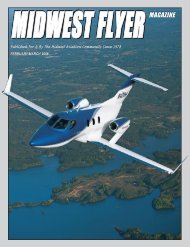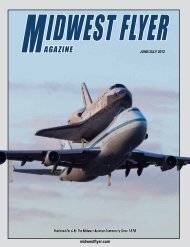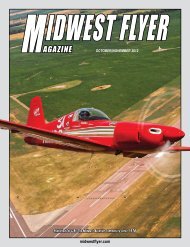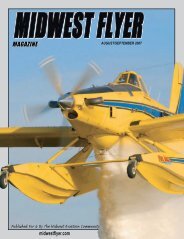AGAZINE - Midwest Flyer
AGAZINE - Midwest Flyer
AGAZINE - Midwest Flyer
Create successful ePaper yourself
Turn your PDF publications into a flip-book with our unique Google optimized e-Paper software.
When do I have to equip?<br />
The rule (14CFR §91.225) requires ADS-B Out<br />
performance on January 1, 2020 when operating in<br />
designated airspace (14CFR §91.227). If you never fly<br />
into the ADS-B designated airspace, then there is no<br />
requirement to equip. However, implementation of the<br />
ADS-B ground infrastructure is already under way with full<br />
implementation of the system expected by the end of 2013.<br />
This implementation schedule allows early adopters of the<br />
technology to realize the benefits of the new system long<br />
before the mandate.<br />
Do my current avionics meet the<br />
performance requirements of the rule?<br />
Your avionics shop and equipment manufacturer can<br />
help you determine if your current equipment meets<br />
the performance requirements of the rule, and they can<br />
advise you on available options and any costs associated<br />
with needed upgrades. Likewise, they can advise you<br />
on the equipment needed for use with available ADS-B<br />
In services. Refer to Advisory Circular 20-165, for<br />
information about equipment certification and installation<br />
requirements.<br />
What is the ADS-B In broadcast service?<br />
ADS-B In services consists of the Flight Information<br />
Service-Broadcast (FIS-B) and the Traffic Information<br />
Service-Broadcast (TIS-B).<br />
FIS-B provides a broad range of textual/graphical<br />
weather products and other flight relevant information to<br />
Universal Access Transceiver (UAT) data equipment users<br />
(FIS-B is not available on 1090ES) to enhance situational<br />
awareness. FIS-B includes the following:<br />
• Aviation Routine Weather Reports (METARs)<br />
• Non-Routine Aviation Weather Reports (SPECIs)<br />
• Terminal Area Forecasts (TAFs) and their amendments<br />
• NEXRAD (regional and CONUS) precipitation maps<br />
• Notice to Airmen (NOTAM) Distant and Flight Data<br />
Center<br />
• Airmen’s Meteorological Conditions (AIRMET)<br />
• Significant Meteorological Conditions (SIGMET) and<br />
Convective SIGMET<br />
• Status of Special Use Airspace (SUA)<br />
• Temporary Flight Restrictions (TFRs)<br />
• Winds and Temperatures Aloft<br />
• Pilot Reports (PIREPS)<br />
• TIS-B service status<br />
TIS-B is an advisory-only service available to both<br />
1090ES and UAT equipment users, which aids in the visual<br />
acquisition of surrounding transponder-based traffic to<br />
increase situational awareness.<br />
I have traffic and weather advisory information now.<br />
How is ADS-B In broadcast services different?<br />
The main difference is that the new ADS-B In broadcast<br />
services do not require subscription or usage fees. If<br />
you choose to equip, the available traffic, weather, and<br />
aeronautical information services can be used free of charge!<br />
At this time it’s very hard to say how much it will cost<br />
to equip a typical GA aircraft. There are many variables<br />
and in Wisconsin if you never fly in or over Green Bay,<br />
Madison or Milwaukee, or above 10,000 feet MSL, you<br />
don’t need ADS-B equipment. With the FAA’s recent<br />
publication of the final rule outlining performance<br />
requirements for ADS-B Out, avionics manufacturers can<br />
proceed in developing and producing the equipment, which<br />
should bring costs down. At this time, the FAA is requiring<br />
ADS-B Out and transponders, meaning pilots will have<br />
to pay for and maintain two systems. The final rule does<br />
indicate that the FAA may, at some future date, consider<br />
whether transponders could eventually be removed.<br />
The northwest part of the state, roughly from La Crosse<br />
to Hayward, has had limited radar coverage where ATC<br />
typically can’t see aircraft below 5,000 feet MSL. The<br />
Wisconsin Bureau of Aeronautics has been working with<br />
the FAA to ensure that the build-out of NextGen closes that<br />
hole, which should greatly improve safety and the efficient<br />
movement of aircraft on IFR flight plans.<br />
q<br />
Life-Saving Pilot, Dorothy Douglas<br />
MADISON, WIS. – Pilot and professor, Dr. Dorothy (DJ)<br />
Douglas, 82, died February 10, 2010. Beginning at age<br />
15, Douglas entered the Civilian Pilot Training Program<br />
during WWII, where she taught Army Air Corps cadets<br />
in Stearman and AT6 aircraft. Because of her expertise in<br />
emergency care, she was commissioned as a Lt. in the Navy<br />
Nurse Corp, sent to Vietnam and flew as a medical crew<br />
chief on Army rescue helicopters. Eventually, she became<br />
a multi-engine and instrument flight instructor, safety<br />
counselor for the FAA, and Commander of the Wisconsin<br />
Wing-Madison Senior Squadron of the Civil Air Patrol, and<br />
flew many search and rescue missions.<br />
Among her numerous awards was the “U.S. Air Force<br />
Life Saving Award” for in-flight directions to a non-pilot<br />
in an emergency situation over Peoria, Illinois. Douglas,<br />
a professor in the School of Nursing at the University of<br />
Wisconsin-Madison, was the eighth woman Judo black belt<br />
in the U.S. She also raced track bicycles in the 1940s and<br />
‘50s, climbed Mt. Ranier, and loved sailing. She is survived<br />
by her partner of 40 years, Rory Ward.<br />
q<br />
AUGUST/SEPTEMBER 2010 MIDWEST FLYER M<strong>AGAZINE</strong> 47
















